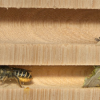Bio
Sarah Peebles is a Toronto-based American composer, improviser and installation artist. Much of her work explores digitally manipulated found sound,
unconventional methods of ampli cation, and distinct approaches to improvisation on the shō, the Japanese mouth-organ used in gagaku. Since 2008 she has
collaborated with artists, technicians and bee biologists on a series of projects addressing pollination ecology and biodiversity, entitled “Resonating Bodies”. Peebles
recent CD, “Delicate Paths” (2014 on Unsounds), highlights her distinct approaches to performing, recording and composing for the shō, with guests Evan Parker,
Nilan Perera, and Suba Sankaran.The album includes a foreword and images dedicated to its ethnobotanical and ethnozooligical connections to ancient Asia.
Peebles’ activities over the past 3 decades have been wide-ranging, including music for dance, multi-channel sound, radio, video/ lm, performance art and
integrated media, sound installation and improvised performance; the duo “Smash and Teeny” with guitarist Nilan Perera, and trio “Cinnamon Sphere” with Perera
and painter Chung Gong. Her music is published on Unsounds, Cycling ’74, innova Recordings, Spool, Post-Concrète, CBC Music, Sonus.ca and others.
Artist’s Statement
Audio Bee Booths & Cabinets
amplified habitat installations for solitary bees and wasps
Because of fluctuating conditions, it is probably not optimal for a plant to evolve too tight a relationship with any one pollinator. They must hedge their bets and
maintain an hierarchy of pollinators. Some apparent inef ciency in the system at any one time may thus be necessary to long-term optimality.
—“Bumble bee Economics” (Bernd Heinrich, Harvard University Press)
I’m interested in bringing people in direct contact with wild bees and their environments in intimate, immersive settings. I have a strong conviction that, in order to
begin to perceive the connections between our actions and their consequences in the larger context, we need to cultivate our mental image of biodiversity, and that
this is best done using all of our senses, outdoors, and immersed in the environment with which we seek to connect. The dynamics of pollination ecology—a
cornerstone of the biosphere as well as of our food security—can be more easily perceived and understood through extending our senses, especially when sound is
paired with visual observation.
Ampli ed habitat installations for native bees and wasps are part of a larger series of collaborations which I began in 2008 with several artists, bee biologists and
pollination ecologists, collectively titled Resonating Bodies. These viewable and listenable homes for solitary bees and wasps are permanent outdoor installations
which bring together sound, sculpture, BioArt and habitat interpretation. Illustrations of pollinators, plants and life cycles tell the story on the outside of the
cabinets. Inside, grooved boards covered with plexiglass provide individual apartments, like condos, for the many varieties of solitary bees and wasps naturally
living nearby. Vibrational sensors embedded in the planks are connected to an ampli er and act as very sensitive microphones. Using headphones and a magnifying
lens, visitors experience a micro world which normally takes place in the dark – safely spying on the bee’s and wasp’s nesting activities, life cycles, parasites, and
their dynamic relationships with the surrounding habitat.
Resonating Bodies is a series of integrated media installations, community outreach projects and a web site which illuminates aspects of Canada’s biodiversity
through focusing on pollination ecology, with special attention paid to the intersection of native bees, habitat and coevolution of plants and pollinators of the
Greater Toronto Area and beyond.
Pollination Wunder Station (short) – audio bee booth from Sarah Peebles on Vimeo.

Comments are closed